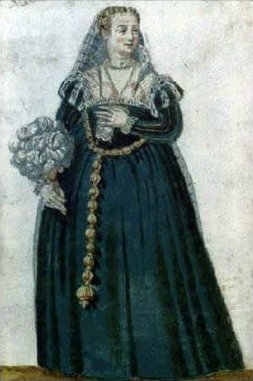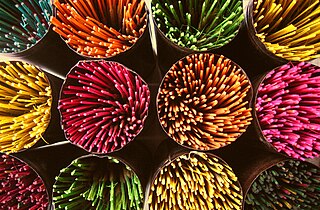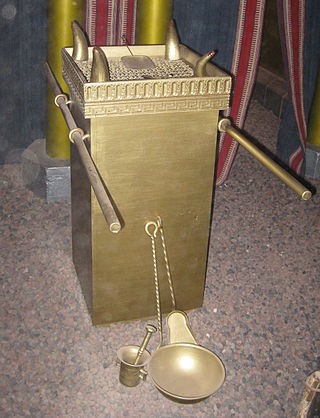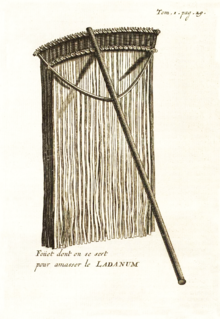
Ambergris, ambergrease, or grey amber is a solid, waxy, flammable substance of a dull grey or blackish colour produced in the digestive system of sperm whales. Freshly produced ambergris has a marine, fecal odor. It acquires a sweet, earthy scent as it ages, commonly likened to the fragrance of isopropyl alcohol without the vaporous chemical astringency.

In polymer chemistry and materials science, a resin is a solid or highly viscous substance of plant or synthetic origin that is typically convertible into polymers. Resins are usually mixtures of organic compounds. This article focuses mainly on naturally occurring resins.

Myrrh is a gum-resin extracted from a few small, thorny tree species of the Commiphora genus, belonging to the Burseraceae family. Myrrh resin has been used throughout history in medicine, perfumery, and incenses. Myrrh mixed with posca or wine was widely used in many ancient cultures to produce pleasurable feelings and as an anti-inflammatory and analgesic.
Perfume is a mixture of fragrant essential oils or aroma compounds (fragrances), fixatives and solvents, usually in liquid form, used to give the human body, animals, food, objects, and living-spaces an agreeable scent. Perfumes can be defined as substances that emit and diffuse a pleasant and fragrant odor. They consist of manmade mixtures of aromatic chemicals and essential oils. The 1939 Nobel Laureate for Chemistry, Leopold Ružička stated in 1945 that "right from the earliest days of scientific chemistry up to the present time, perfumes have substantially contributed to the development of organic chemistry as regards methods, systematic classification, and theory."

Incense is an aromatic biotic material that releases fragrant smoke when burnt. The term is used for either the material or the aroma. Incense is used for aesthetic reasons, religious worship, aromatherapy, meditation, and ceremony. It may also be used as a simple deodorant or insect repellent.

Onycha, along with equal parts of stacte, galbanum, and frankincense, was one of the components of the consecrated Ketoret (incense) which appears in the Torah book of Exodus (Ex.30:34-36) and was used in the Jerusalem's Solomon's Temple. This formula was to be incorporated as an incense, and was not to be duplicated for non-sacred use. What the onycha of antiquity actually was cannot be determined with certainty. The original Hebrew word used for this component of the ketoret was שחלת, shecheleth, which means "to roar; as a lion " or “peeling off by concussion of sound." Shecheleth is related to the Syriac shehelta which is translated as “a tear, distillation, or exudation.” In Aramaic, the root SHCHL signifies “retrieve.” When the Torah was translated into Greek the Greek word “onycha” ονυξ, which means "fingernail" or "claw," was substituted for shecheleth.

Benzoin or benjamin is a balsamic resin obtained from the bark of several species of trees in the genus Styrax. It is used in perfumes and some kinds of incense and as a flavoring and medicine. It is distinct from the chemical compound benzoin, which is ultimately derived chemically from benzoin resin; the primary active ingredient of benzoin resin is actually benzoic acid not benzoin.

Cistus ladanifer is a species of flowering plant in the family Cistaceae. It is native to the western Mediterranean region. Common names include gum rockrose, labdanum, common gum cistus, and brown-eyed rockrose.
Oleoresins are semi-solid extracts composed of resin and essential or fatty oil, obtained by evaporation of the solvents used for their production. The oleoresin of conifers is known as crude turpentine or gum turpentine, which consists of oil of turpentine and rosin.

A pomander, from French pomme d'ambre, i.e., apple of amber, is a ball made for perfumes, such as ambergris, musk, or civet. The pomander was worn or carried in a case as a protection against infection in times of pestilence or merely as a useful article to modify bad smells. The globular cases which contained the pomanders were hung from a neck-chain or belt or attached to the girdle, and were usually perforated in a variety of openwork techniques and made of gold or silver. Sometimes they contained several partitions, in each of which was placed a different perfume.

Galbanum is an aromatic gum resin and a product of certain umbelliferous Persian plant species in the genus Ferula, chiefly Ferula gummosa and Ferula rubricaulis. Galbanum-yielding plants grow plentifully on the slopes of the mountain ranges of northern Iran. It occurs usually in hard or soft, irregular, more or less translucent and shining lumps, or occasionally in separate tears, of a light-brown, yellowish or greenish-yellow colour. Galbanum has a disagreeable, bitter taste, a peculiar, a somewhat musky odour, and an intense green scent. With a specific gravity of 1.212, it contains about 8% terpenes; about 65% of a resin which contains sulfur; about 20% gum; and a very small quantity of the colorless crystalline substance umbelliferone. It also contains α-pinene, β-pinene, limonene, cadinene, 3-carene, and ocimene.

India is the world's main incense producing country, and is a major exporter to other countries. In India, incense sticks, called Agarbatti (Agar: from Dravidian probably Tamil அகில், அகிர் ., Sanskrit varti, meaning "stick" An older term "Dhūpavarti" is more commonly used in ancient and medieval texts which encompasses various types of stick incense recipes. Incense is part of the cottage industry in India and important part of many religions in the region since ancient times. The method of incense making with a bamboo stick as a core originated in India at the end of the 19th century, largely replacing the rolled, extruded or shaped method which is still used in India for dhoop.
Chypre is the name of a family of perfumes that are characterised by an accord composed of citrus top notes, a middle centered on cistus labdanum, and a mossy-animalic set of basenotes derived from oakmoss. Chypre perfumes fall into numerous classes according to their modifier notes, which include but are not limited to leather, florals, fruits, and amber.

The word perfume is used today to describe scented mixtures and is derived from the Latin word, "per fumus," meaning through smoke. The word perfumery refers to the art of making perfumes. Perfume was refined by the Romans, the Persians and the Arabs. Although perfume and perfumery also existed in East Asia, much of its fragrances were incense based. The basic ingredients and methods of making perfumes are described by Pliny the Elder in his Naturalis Historia.

The crook and flail were symbols used in ancient Egyptian society. They were originally the attributes of the deity Osiris that became insignia of pharaonic authority. The shepherd's crook stood for kingship and the flail for the fertility of the land.

Attar, also known as ittar, is an essential oil derived from botanical or other natural sources. Most commonly these oils are extracted via hydrodistillation or steam distillation. The Persian physician Ibn Sina was first to derive the attar of flowers from distillation. Attar can also be expressed by chemical means but generally natural perfumes which qualify as attars are distilled with water. The oils are generally distilled into a wood base such as sandalwood and then aged. The aging period can last from one to ten years depending on the botanicals used and the results desired. Technically attars are distillates of flowers, herbs, spices and other natural materials such as baked soil over sandalwood oil/liquid paraffins using hydrodistillation technique involving a still and receiving vessel. These techniques are still in use today at Kannauj in India.

Stacte and nataph are names used for one component of the Solomon's Temple incense, the Ketoret, specified in the Book of Exodus. Variously translated to the Greek term or to an unspecified "gum resin" or similar, it was to be mixed in equal parts with onycha, galbanum and mixed with pure frankincense and they were to "beat some of it very small" for burning on the altar of the tabernacle.

The incense offering in Judaism was related to perfumed offerings on the altar of incense in the time of the Tabernacle and the First and Second Temple period, and was an important component of priestly liturgy in the Temple in Jerusalem.
The incense offering, a blend of aromatic substances that exhale perfume during combustion, usually consisting of spices and gums burnt as an act of worship, occupied a prominent position in the sacrificial legislation of the ancient Hebrews.
















